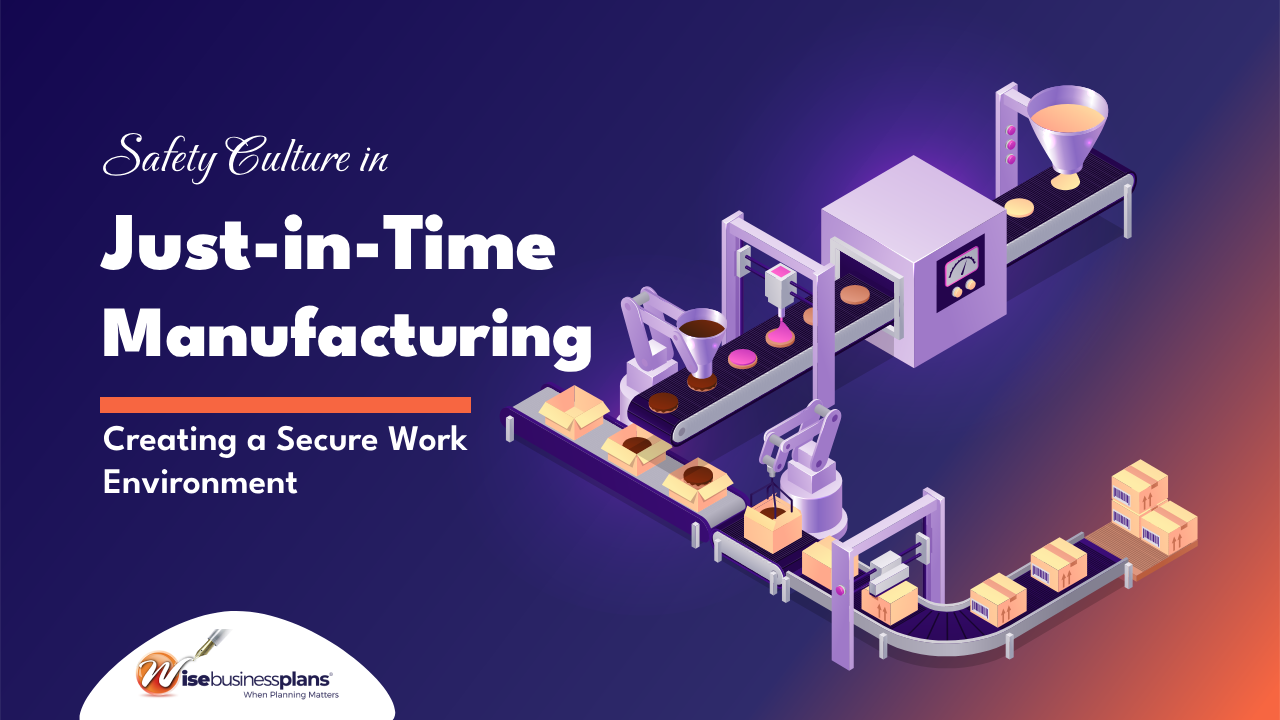Safety Culture in Just-in-Time Manufacturing: Creating a Secure Work Environment
Table of Contents
- Key Highlights
- Just-in-Time Manufacturing: Understanding the Safety Risks
- Safety and Security Issues Affecting Manufacturing
- Safety Risks Facing Personnel in Just-in-Time Manufacturing
- Inventory Management: A Critical Safety Component in Just-in-Time Manufacturing
- The Role of Technology in Ensuring Safety in Just-in-Time Manufacturing
- Looking for someone to write a Business Plan?
- Employee Training and Adaptability in Just-in-Time Manufacturing
- Safety and Security: A Critical Component of Just-in-Time Manufacturing
Just-in-time manufacturing is a complex ballet of separate components working together as a cohesive and efficient whole. Promoting a safe and secure environment in such a situation can be challenging.
One of the factors that makes it so difficult is the complexity of just-in-time manufacturing. It is a process that includes many variables, and the problem with variables is – they vary. Trying to predict safety issues and protect against them in such circumstances is where the challenges arise.
Safety and security should not be seen as separate entities when it comes to just-in-time manufacturing, rather it should be considered as one of the components to include in the process.
Let’s look at some of the safety challenges and the tools and processes that can bolster security.
Key Highlights
- Just-in-time manufacturing depends on a delicate balance and can be vulnerable to disruptions in supply chain, security breaches, and quality issues.
- Safety challenges in just-in-time manufacturing include worker stress, physical hazards, inadequate training, and ergonomic concerns.
- Good inventory management with real-time tracking, predictive analysis, and automated alerts can significantly reduce safety risks in just-in-time manufacturing.
Just-in-Time Manufacturing: Understanding the Safety Risks
We can break this down into two distinct areas – personnel safety, and the integrity of the manufacturing process. Both present distinct and complex challenges that need to be addressed.
Safety and Security Issues Affecting Manufacturing
Just-in-time manufacturing is an effective and efficient method of keeping manufacturing costs lower. However, it also requires a delicate balancing act that hinges on precise timing, coordination, and trust in various components of the supply chain. This intricate system, while beneficial, introduces several vulnerabilities:
- Supply Chain Dependence: A minor hiccup with a single supplier can ripple through the entire production process, leading to significant delays or halts.
- Theft and Vandalism Risks: With valuable equipment and products often in transit or stored in accessible locations, production facilities can become prime targets.
- Data and Digital Threats: The manufacturing process relies on real-time data and digital coordination, it’s susceptible to cyber-attacks that can disrupt schedules or compromise sensitive information.
- Quality Assurance Challenges: The rapid turnover and continuous flow can sometimes overshadow quality checks, risking product recalls or reputational damage.
These vulnerabilities highlight the need for robust safety and security measures to protect the integrity of the just-in-time process.
Get Our Professional Business Plan Writing Services Now!
Safety Risks Facing Personnel in Just-in-Time Manufacturing
The safety and security of staff is of obvious importance in any working environment. The complexities of just-in-time manufacturing, with its fast-paced and interconnected processes, introduce unique challenges that can impact the well-being of the workforce:
- Workplace Stress: The continuous and often high-pressure nature of the factory floor can lead to increased stress levels among workers, potentially resulting in fatigue, burnout, or oversights.
- Physical Hazards: The need for rapid movement of goods and materials can lead to overcrowded workspaces, increasing the risk of accidents or mishandling.
- Inadequate Training: Just-in-time manufacturing evolves and integrates new technologies rapidly. This creates risks that employees might not receive timely training, leaving them ill-equipped to handle certain machinery or processes safely.
- Ergonomic Concerns: The repetitive and time-sensitive tasks in just-in-time manufacturing can lead to ergonomic issues, with workers potentially facing long-term health concerns if not addressed.
Recognizing and addressing these personnel-related challenges is crucial to ensure not only the efficiency of manufacturing but also the health and morale of the workforce.
Inventory Management: A Critical Safety Component in Just-in-Time Manufacturing
Inventory and production management is one of the core components of just-in-time manufacturing. The importance of this component cannot be overstated in maintaining the integrity of the supply chain and potentially reducing the risks faced by workers.
A well-orchestrated inventory system can be the difference between a safe, efficient workspace and one riddled with hazards and inefficiencies. Here are a few of the main ways that good inventory management can reduce the “risk factor” in just-in-time manufacturing.
- Real-time Tracking: Modern inventory management systems offer real-time tracking of goods. This ensures that storage areas are not overcrowded, reducing the risk of accidents due to clutter or mishandling of goods.
- Predictive Analysis: Advanced systems can predict demand fluctuations, allowing for better preparation and reducing the chances of overworking or rushed processes that might compromise safety.
- Automated Alerts: Automated systems can send alerts for potential issues, such as equipment malfunctions or supply shortages, allowing for proactive measures before they escalate into safety concerns.
- Training and Accessibility: Ensuring that all personnel are trained in using inventory management tools and have easy access to safety protocols integrated within these systems can drastically reduce human errors.
- Supplier Coordination: Effective inventory management also involves coordinating with suppliers to ensure timely and safe deliveries, reducing the chances of last-minute rushes or unsafe storage practices.
Inventory management can be considered the “hub” of just-in-time manufacturing; it is a core component that is instrumental in orchestrating the seamless flow of goods, ensuring timely production, and minimizing potential disruptions. By performing these actions efficiently it is also a critical safety factor at the heart of just-in-time manufacturing.
Checkout Our Professional Business Plan Examples Now!
The Role of Technology in Ensuring Safety in Just-in-Time Manufacturing
The use of technology in just-in-time manufacturing is nothing new. The process has always leaned heavily on the integration of the latest technologies to streamline and automate processes.
This is more relevant than ever today. Manufacturing industry trends have seen the adoption of technologies like AI, IoT, and cloud-based computing. These have greatly increased the potential of technology to revolutionize the factory floor and enhance the safety and security of just-in-time manufacturing.
Some of the ways it can achieve this include:
- Real-time Monitoring: Advanced sensors and IoT devices can provide real-time data on equipment performance, allowing for timely maintenance and reducing the risk of malfunctions.
- AI-driven Predictive Analysis: AI can analyze vast amounts of data to predict potential disruptions, from supply chain issues to equipment failures, allowing for proactive measures.
- Cloud-based Coordination: Cloud platforms enable seamless coordination between different components of the manufacturing process, ensuring that all parts are in sync and reducing the chances of errors or oversights.
- Access Control Systems: Utilizing biometrics, smart cards, or facial recognition, these systems ensure that only authorized personnel access critical areas, preventing unauthorized entry and enhancing security.
- Enhanced Surveillance: The integration of cameras ensures discreet yet comprehensive surveillance of the factory floor. For instance, PTZ cameras can detect unauthorized access or potential safety hazards, providing an added layer of security.
- Automated Safety Protocols: In case of emergencies, automated systems can initiate safety protocols, from shutting down machinery to alerting relevant personnel, ensuring swift response times.

Looking for someone to write a Business Plan?
Hire our professional business plan writer
Employee Training and Adaptability in Just-in-Time Manufacturing
The ability to adapt to ever-changing circumstances is critical in ensuring the efficiency and safety of just-in-time manufacturing. Despite the increasing role of technology and the trends driving more automation, the human factor remains a key factor in ensuring this adaptability.
Some of the methods that manufacturers are using to achieve this include:
- Continuous Training: Regular workshops and training sessions on the latest tools and safety protocols.
- Feedback Loops: Encouraging employees to provide feedback on technological tools, helping in refining and enhancing safety measures.
- Adaptability Workshops: Sessions focused on helping employees adapt to rapid technological changes, ensuring they remain agile and informed.
Technology can do many things, but humans remain the most essential element of the manufacturing process.
Get Our Professional Business Plan Writing Services Now!
Safety and Security: A Critical Component of Just-in-Time Manufacturing
When just-in-time manufacturing works as it should, it is a thing of wonder. The harmony of separate components seamlessly working together to efficiently and timeously facilitate manufacturing is akin to a well-orchestrated symphony. However, to maintain this rhythm, safety and security must be at the forefront.
Safety is not an afterthought in just-in-time manufacturing, it is one of the core components and should be treated as such.




![How to Implement Security Measures That Actually Protect Your Business [Step-by-Step Guide]](https://wisebusinessplans.com/wp-content/uploads/2025/06/how-to-implement-security-measures-that-actually-protect-your-business-1024x576.webp)











